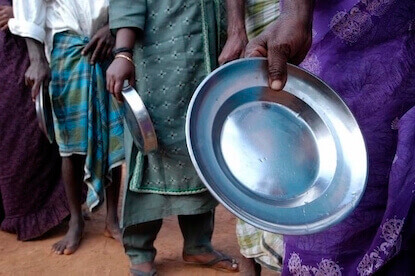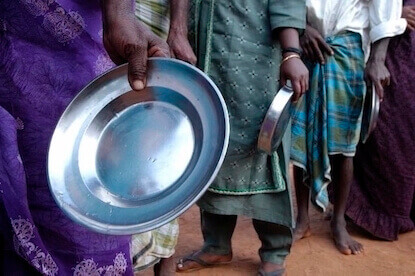Global Food Crisis. The world is entering a new era of global food crisis where rising food prices, poverty, starvation and food survival will become the new normal. Most worry, others speculate.
These three words are starting to cause alarm in many parts of the world. No longer is the term food crisis reserved for the under developed nations of the world where millions live in poverty and face starvation every day. Food crisis is now a phrase heard in the developed countries of Europe and even more surprisingly; the United States. One problem is that impoverished people struggle to feed themselves using outdated agricultural systems that have outlived their usefulness. These outdated methods just can’t keep up with the demands of a world that grows by more than 250,000 people per day. Another is a changing climate that is threatening once stable agricultural areas of the world with changes not seen since the period before the last ice age 300,000 years ago.
These are just some of the reasons that the world is quickly approaching the precipice edge, that once crossed, will see poverty and starvation that may last a century or more. As recently as 2008, 25 countries experienced riots in the streets over a steep increase in food prices. Governments were overthrown and millions forced into poverty became refugees. War has replaced peace in many parts of the world; all because of a food shortage and higher food prices.
An expert global food crisis panel at The United Nations issued a warning in July, 2012 that the world’s agricultural supply system was close to collapse which threatened to drive millions of people into poverty, starve millions more and spark rioting that may bring down even more governments. If that wasn’t bad enough, The Earth Policy Research Center has officially commented that the world's climate is changing so fast and in such an unpredictable way that a collapse of the global food supply system is inevitable. It’s just a matter of time before two-thirds the world's population lives in poverty; many facing starvation.
For The Seventh Year In Twelve, The Planet Has Consumed More Food Than It Produces.
While governments around the world worry about the looming food crisis, a crisis many experts believe is a planet changing problem that may undermine civilization itself, market speculators exasperate the problem further driving food prices even higher. While America fights for oil in the Middle East, China is spearheading a global “land grab for millions of acres of cheap farmland in far away places like Africa and Argentina in an effort to feed its people.



For the seventh year in twelve, the planet has consumed more food than it produces, draining food reserves to their lowest level since countries began stockpiling decades ago. China's food situation is dire; some believe that China’s food reserves would only last a month in the event of some catastrophic global event or a collapse of the global food supply system. Just 10 years ago, it took 20% of the income earned by the poorer peoples of the world to pay for food; today it has soared to 80% in many countries forcing millions of people into poverty and starvation. New food production technology is key to solving the world's hunger and starvation problems. In the 1960’s the introduction of new technology was part of the green revolution that saw a three fold increase in food production after just a few short years. The next generation food technology could do the same thing today.
Global Food Crisis And Food Security - Only Half The World Has It
Food security is built on three basic principles; a person consistently having sufficient quantities of food available, a person having the resources to obtain the right kind of foods to maintain a nutritious diet and a person having access to adequate amounts of clean water and sanitation. In most developing countries, agriculture is the largest source of employment strong>and serves as a direct link to providing food security. Unfortunately, the trend of developing countries to enter into one-sided agricultural agreements with multinational corporations has reduced the number of people directly employed by agriculture in these countries. The result is the removal of millions of people worldwide from a simple rural life that once provided basic food security. Now, developing nations are renegotiating these agreements so tariffs may be raised on key food products to better protect farm employment and that country's food security. The best way to provide food security is help people to become more self sufficient in their food growing practices. Many people, particularly in the developing world are using outdated technologies and work by hand or oxen. Although arguably better for the environment, it takes thousands of people all doing the same thing to feed a town or village.
Global Food Crisis And Food Shortages - Simply Not Enough Resources
Food shortage in modern times? Hard to believe, but here we are. Most of us are familiar with the stories and pictures out of Africa and other parts of the world depicting the plight of nearly one third of the world’s population; people dying from hunger and starvation. Some of us gladly contributed to NGO’s in some small way to try and make a difference for those of us less fortunate. The problem however is much bigger than we think and a little closer to home as well. A tremendous amount of the world’s resources are devoted to raising animal protein, which supplies about 25% of protein consumed by humans around the world. According to leading researchers, that number is going to have to drop to about 5% if we are going to feed the 2 billion people that are expected to be added to the planet in the next 30 years. That means roughly half of us will have to adopt a vegetarian diet if we are going to have any chance of averting this planet's looming food crisis.
Global Food Crisis And Food Control - The Pushback Against Global Agriculture
Traditional farming is threatened by large corporate interests all over the world and unfortunately for small farms, it’s the larger farms owned and operated by agribusiness that have been making most of the money for the past 40 years. This type of food control has caused many farms across the country and indeed around the world to disappear. This shift to large corporate farms has left many smaller farmers unable to earn a living doing something they were born to do – run the family farm. These days, income from small farms in America averages just $10,000 annually, forcing many farmers to supplement their income with a full or part time job to survive. Unfortunately, many give up and sell the farm outright to larger interests. If we are going to save the family farm and support community agriculture, new and innovative farming technologies must be developed. The current corporate farm with chemical food production & delivery system is a significant contributor to climate change, loss of biodiversity, pollution and water shortages as well as preventable disease and poverty. The good news is there has been a “breakthrough” development in food growing technology that will greatly benefit even the smallest farms with the least amount of land, particularly in the developing world: a technology that grows more food in less space. Crop Circles.